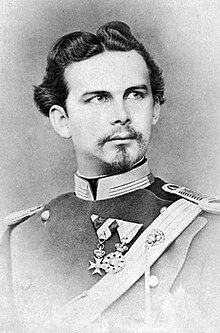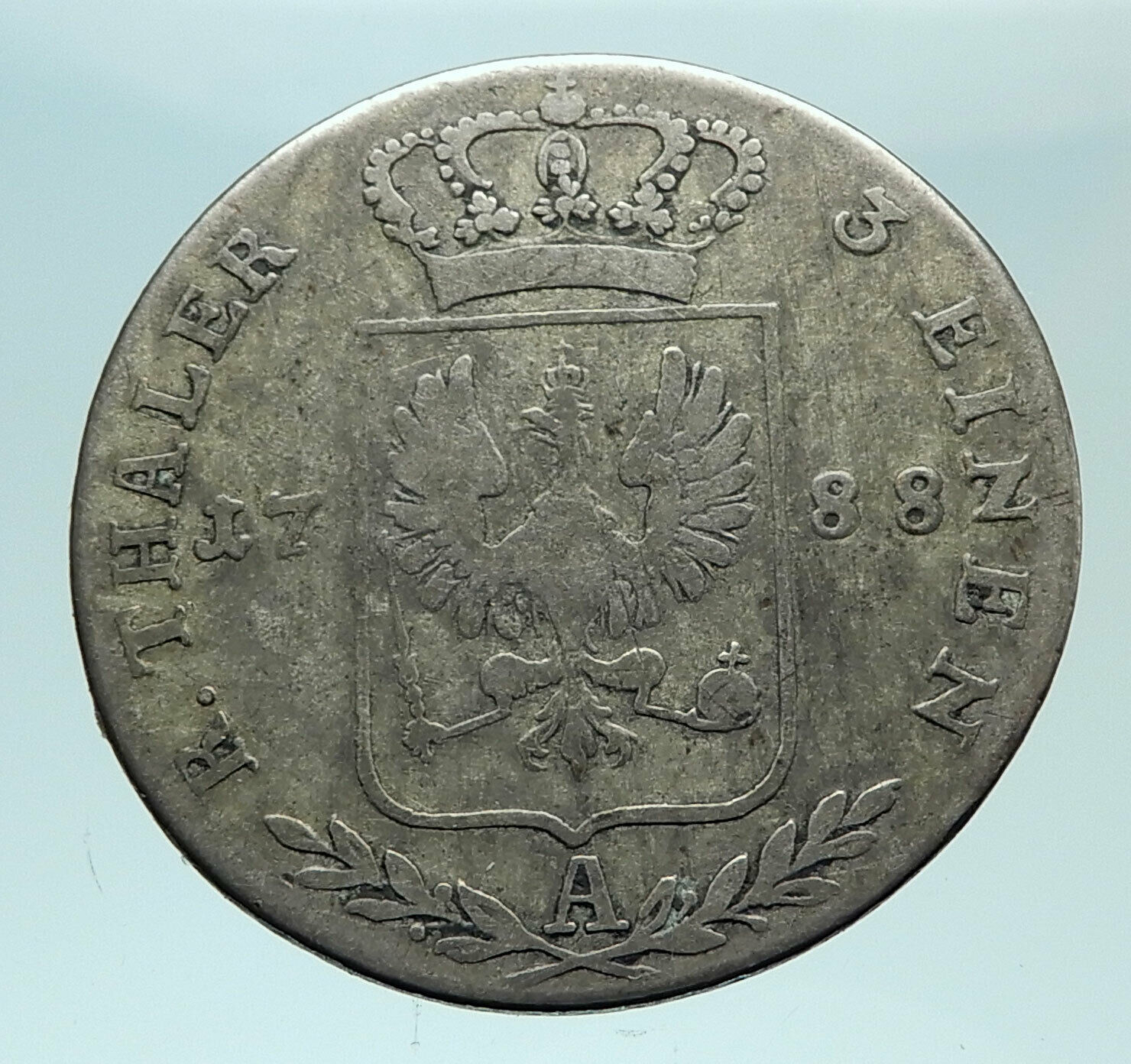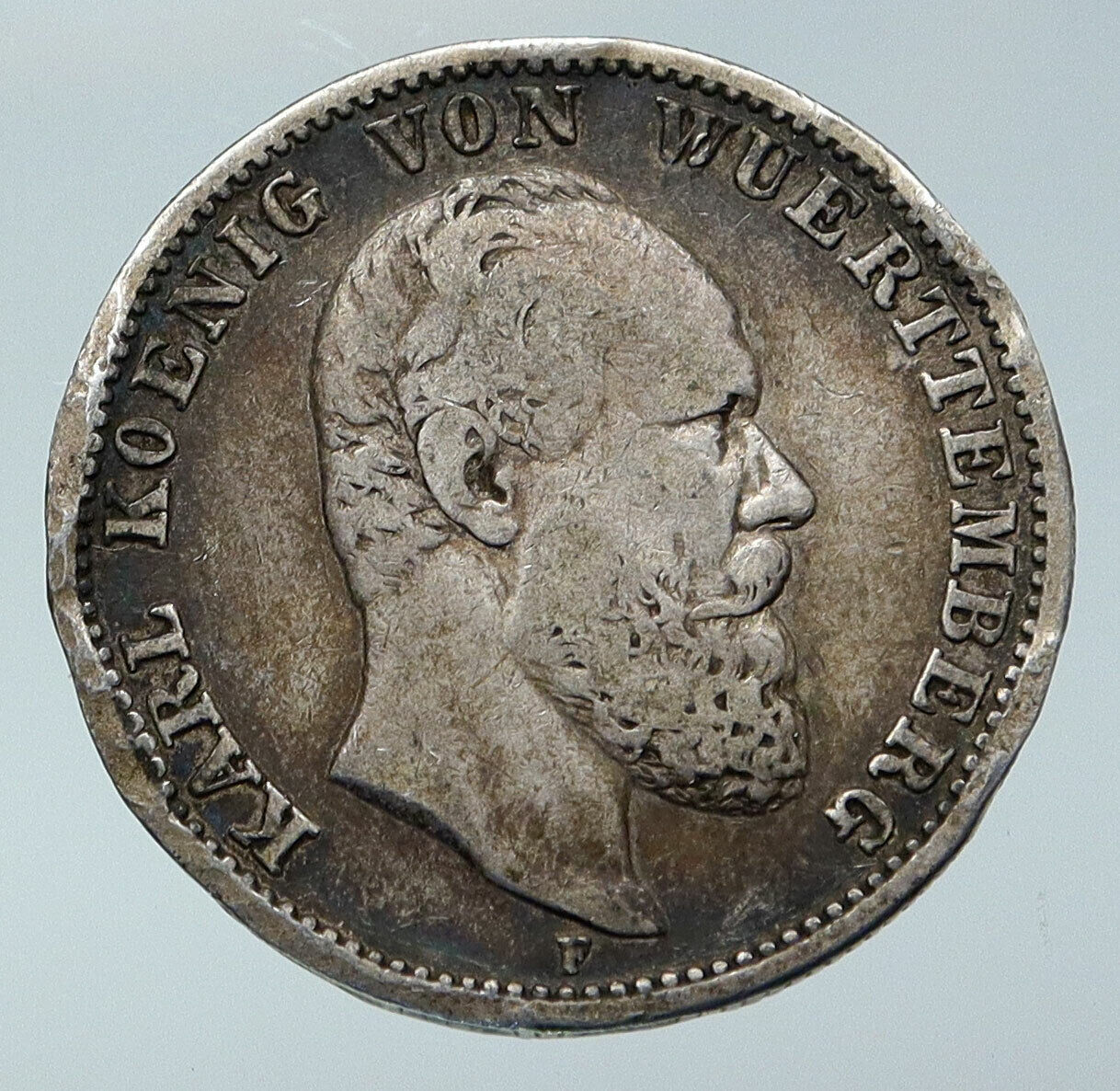|
KINGDOM of BAVARIA, Germany under Ludwig II: King – 10 March 1864 – 13 June 1886
1875 Silver 5 Mark 37mm (27.52 grams) 0.900 Silver (0.8037 oz. ASW)
Reference: KM# 896
LUDWIG II KŒNIG V. BAYERN D, Ludwig facing right.
DEUTSCHES REICH * FÜNF MARK *, Crowned eagle with shield.
Edge Lettering:
GOTT MIT UNS (Dieu avec nous)
You are bidding on the exact item pictured, provided with a Certificate of Authenticity and Lifetime Guarantee of Authenticity.
The Kingdom of Bavaria (German: Königreich Bayern; Austro-Bavarian: Kinereich Bayern) was a German state that succeeded the former Electorate of Bavaria in 1805 and continued to exist until 1918. The Bavarian Elector Maximilian IV Joseph of the House of Wittelsbach became the first King of Bavaria in 1805 as Maximilian I Joseph. The crown would go on being held by the Wittelsbachs until the kingdom came to an end in 1918. Most of Bavaria’s present-day borders were established after 1814 with the Treaty of Paris, in which Bavaria ceded Tyrol and Vorarlberg to the Austrian Empire while receiving Aschaffenburg and Würzburg. With the unification of Germany into the German Empire in 1871, the kingdom became a federal state of the new Empire and was second in size, power, and wealth only to the leading state, the Kingdom of Prussia. In 1918, Bavaria became a republic, and the kingdom was thus succeeded by the current Free State of Bavaria.
 Ludwig II (German: Ludwig Otto Friedrich Wilhelm; English: Louis Otto Frederick William; 25 August 1845 – 13 June 1886) was King of Bavaria from 1864 until his death in 1886. He is sometimes called the Swan King or der Märchenkönig (“the Fairy Tale King”). He also held the titles of Count Palatine of the Rhine, Duke of Bavaria, Duke of Franconia, and Duke in Swabia. Ludwig II (German: Ludwig Otto Friedrich Wilhelm; English: Louis Otto Frederick William; 25 August 1845 – 13 June 1886) was King of Bavaria from 1864 until his death in 1886. He is sometimes called the Swan King or der Märchenkönig (“the Fairy Tale King”). He also held the titles of Count Palatine of the Rhine, Duke of Bavaria, Duke of Franconia, and Duke in Swabia.
He succeeded to the throne aged 18. Two years later, in 1866, Bavaria and Austria fought a war against Prussia lasting only a matter of weeks, which they lost. However, in the Franco-Prussian War of 1870 Bavaria sided with Prussia against France, and after the Prussian victory it became part of the new German Empire led by Prussia. Though Bavaria retained a degree of autonomy on some matters within the new German Reich, Ludwig increasingly withdrew from day-to-day affairs of state in favour of extravagant artistic and architectural projects. He commissioned the construction of two lavish palaces and Neuschwanstein Castle, and he was a devoted patron of the composer Richard Wagner. Ludwig spent all his royal revenues (although not state funds as is commonly thought) on these projects, borrowed extensively, and defied all attempts by his ministers to restrain him. This extravagance was used against him to declare him insane, an accusation which has since come under scrutiny. Today, his architectural and artistic legacy includes many of Bavaria’s most important tourist attractions.
Born at Nymphenburg Palace (today located in suburban Munich), he was the elder son of Maximilian II of Bavaria and Marie of Prussia, Crown Prince and Princess of Bavaria, who became King and Queen in 1848 after the abdication of the former’s father, Ludwig I, during the German Revolution. His parents intended to name him Otto, but his grandfather insisted that his grandson be named after him, since their common birthday, 25 August, is the feast day of Saint Louis IX of France, patron saint of Bavaria (with “Ludwig” being the German form of “Louis”). His younger brother, born three years later, was named Otto.
Like many young heirs in an age when kings governed most of Europe, Ludwig was continually reminded of his royal status. King Maximilian wanted to instruct both of his sons in the burdens of royal duty from an early age. Ludwig was both extremely indulged and severely controlled by his tutors and subjected to a strict regimen of study and exercise. There are some who point to these stresses of growing up in a royal family as the causes for much of his odd behavior as an adult.
Ludwig was not close to either of his parents. King Maximilian’s advisers had suggested that on his daily walks he might like, at times, to be accompanied by his future successor. The King replied, “But what am I to say to him? After all, my son takes no interest in what other people tell him.” Later, Ludwig would refer to his mother as “my predecessor’s consort”. He was far closer to his grandfather, the deposed and notorious King Ludwig I.
Ludwig’s childhood years did have happy moments. He lived for much of the time at Castle Hohenschwangau, a fantasy castle his father had built near the Alpsee (Alp Lake) near Füssen. It was decorated in the Gothic Revival style with many frescoes depicting heroic German sagas. The family also visited Lake Starnberg. As an adolescent, Ludwig became close friends with his aide de camp, Prince Paul, a member of the wealthy Bavarian Thurn und Taxis family. The two young men rode together, read poetry aloud, and staged scenes from the Romantic operas of Richard Wagner. The friendship ended when Paul became engaged in 1866 with a commoner. During his youth, Ludwig also initiated a lifelong friendship with his cousin Duchess Elisabeth in Bavaria, later Empress of Austria.
Crown Prince Ludwig was in his 19th year when his father died after a three-day illness, and he ascended the Bavarian throne. Although he was not prepared for high office, his youth and brooding good looks made him popular in Bavaria and elsewhere. He continued the state policies of his father and retained his ministers.
His real interests were in art, music, and architecture. One of the first acts of his reign, a few months after his accession, was to summon Wagner to his court. Also in 1864, he laid the foundation stone of a new Court Theatre, now the Staatstheater am Gärtnerplatz (Gärtnerplatz-Theater).
Ludwig was notably eccentric in ways that made serving as Bavaria’s head of state problematic. He disliked large public functions and avoided formal social events whenever possible, preferring a life of seclusion that he pursued with various creative projects. He last inspected a military parade on 22 August 1875 and last gave a Court banquet on 10 February 1876. His mother had foreseen difficulties for Ludwig when she recorded her concern for her extremely introverted and creative son who spent much time day-dreaming. These idiosyncrasies, combined with the fact that Ludwig avoided Munich and participating in the government there at all costs, caused considerable tension with the king’s government ministers, but did not cost him popularity among the citizens of Bavaria. The king enjoyed traveling in the Bavarian countryside and chatting with farmers and labourers he met along the way. He also delighted in rewarding those who were hospitable to him during his travels with lavish gifts. He is still remembered in Bavaria as “Unser Kini” (“our cherished king” in the Bavarian dialect).
Austro-Prussian and Franco-Prussian Wars
Unification with Prussia took center stage from 1866. In the Austro-Prussian War, which began in August, Ludwig supported Austria against Prussia. Austria and Bavaria were defeated, and Bavaria was forced to sign a mutual defense treaty with Prussia. When the Franco-Prussian War broke out in 1870, Bavaria was required to fight alongside Prussia. After the Prussian victory over France, Bismarck moved to complete the Unification of Germany.
In November 1870, Bavaria joined the North German Confederation and thus lost its status as an independent kingdom. However, the Bavarian delegation under Minister-President Count Otto von Bray-Steinburg secured privilleged status for Bavaria within the Empire (Reservatrechte). Bavaria retained its own diplomatic corps and its own army, which would come under Prussian command only in times of war.
In December 1870, Bismarck used financial concessions to induce Ludwig with the support of the king’s equerry Maximilian Count von Holnstein to write the so-called Kaiserbrief, a letter endorsing the creation of the German Empire with King Wilhelm I of Prussia as Emperor. Nevertheless, Ludwig regretted Bavaria’s loss of independence and refused to attend Wilhelm’s 18 January proclamation as German Emperor in the Palace of Versailles. Ludwig’s brother Prince Otto and his uncle Luitpold went instead. Otto criticized the celebration as ostentatious and heartless in a letter to his brother.
  Germany, officially the Federal Republic of Germany is a federal parliamentary republic in western-central Europe. It includes 16 constituent states and covers an area of 357,021 square kilometres (137,847 sq mi) with a largely temperate seasonal climate. Its capital and largest city is Berlin. With 81 million inhabitants, Germany is the most populous member state in the European Union. After the United States, it is the second most popular migration destination in the world. Germany, officially the Federal Republic of Germany is a federal parliamentary republic in western-central Europe. It includes 16 constituent states and covers an area of 357,021 square kilometres (137,847 sq mi) with a largely temperate seasonal climate. Its capital and largest city is Berlin. With 81 million inhabitants, Germany is the most populous member state in the European Union. After the United States, it is the second most popular migration destination in the world.
Various Germanic tribes have occupied northern Germany since classical antiquity. A region named Germania was documented before 100 CE. During the Migration Period the Germanic tribes expanded southward. Beginning in the 10th century, German territories formed a central part of the Holy Roman Empire. During the 16th century, northern German regions became the centre of the Protestant Reformation.
The rise of Pan-Germanism inside the German Confederation resulted in the unification of most of the German states in 1871 into the Prussian-dominated German Empire. After World War I and the German Revolution of 1918-1919, the Empire was replaced by the parliamentary Weimar Republic. The establishment of the Third Reich in 1933 led to World War II and the Holocaust. After 1945, Germany split into two states, East Germany and West Germany. In 1990, the country was reunified.
 In the 21st century, Germany is a great power and has the world’s fourth-largest economy by nominal GDP, as well as the fifth-largest by PPP. As a global leader in several industrial and technological sectors, it is both the world’s third-largest exporter and importer of goods. Germany is a developed country with a very high standard of living sustained by a skilled and productive society. It upholds a social security and universal health care system, environmental protection and a tuition free university education. In the 21st century, Germany is a great power and has the world’s fourth-largest economy by nominal GDP, as well as the fifth-largest by PPP. As a global leader in several industrial and technological sectors, it is both the world’s third-largest exporter and importer of goods. Germany is a developed country with a very high standard of living sustained by a skilled and productive society. It upholds a social security and universal health care system, environmental protection and a tuition free university education.
Germany was a founding member of the European Union in 1993. It is part of the Schengen Area, and became a co-founder of the Eurozone in 1999. Germany is a member of the United Nations, NATO, the G8, the G20, and the OECD. The national military expenditure is the 9th highest in the world. Known for its rich cultural history, Germany has been continuously the home of influential artists, philosophers, musicians, sportsmen, entrepreneurs, scientists and inventors.
|





 Ludwig II (German: Ludwig Otto Friedrich Wilhelm; English: Louis Otto Frederick William; 25 August 1845 – 13 June 1886) was King of Bavaria from 1864 until his death in 1886. He is sometimes called the Swan King or der Märchenkönig (“the Fairy Tale King”). He also held the titles of Count Palatine of the Rhine, Duke of Bavaria, Duke of Franconia, and Duke in Swabia.
Ludwig II (German: Ludwig Otto Friedrich Wilhelm; English: Louis Otto Frederick William; 25 August 1845 – 13 June 1886) was King of Bavaria from 1864 until his death in 1886. He is sometimes called the Swan King or der Märchenkönig (“the Fairy Tale King”). He also held the titles of Count Palatine of the Rhine, Duke of Bavaria, Duke of Franconia, and Duke in Swabia. 
 Germany, officially the Federal Republic of Germany is a federal parliamentary republic in western-central Europe. It includes 16 constituent states and covers an area of 357,021 square kilometres (137,847 sq mi) with a largely temperate seasonal climate. Its capital and largest city is Berlin. With 81 million inhabitants, Germany is the most populous member state in the European Union. After the United States, it is the second most popular migration destination in the world.
Germany, officially the Federal Republic of Germany is a federal parliamentary republic in western-central Europe. It includes 16 constituent states and covers an area of 357,021 square kilometres (137,847 sq mi) with a largely temperate seasonal climate. Its capital and largest city is Berlin. With 81 million inhabitants, Germany is the most populous member state in the European Union. After the United States, it is the second most popular migration destination in the world. In the 21st century, Germany is a great power and has the world’s fourth-largest economy by nominal GDP, as well as the fifth-largest by PPP. As a global leader in several industrial and technological sectors, it is both the world’s third-largest exporter and importer of goods. Germany is a developed country with a very high standard of living sustained by a skilled and productive society. It upholds a social security and universal health care system, environmental protection and a tuition free university education.
In the 21st century, Germany is a great power and has the world’s fourth-largest economy by nominal GDP, as well as the fifth-largest by PPP. As a global leader in several industrial and technological sectors, it is both the world’s third-largest exporter and importer of goods. Germany is a developed country with a very high standard of living sustained by a skilled and productive society. It upholds a social security and universal health care system, environmental protection and a tuition free university education.




